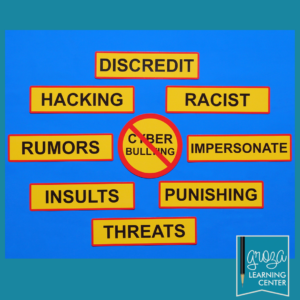
Cyberbullying: The Ugly Truth
Cyberbullying is an undeniable truth, defined as the use of electronic communication (social media platforms, websites, apps, texts) to bully a person, typically by sending messages of an intimidating or threatening nature with the intention of hurting or harming another person. Cyberbullying is even more damaging than face-to-face bullying since it can happen anytime, anywhere, across many platforms, and in front of a large audience. Not only can the perpetrator strike at any time, but they have also added layers of protection; anonymity, pseudonyms, and distance. Furthermore, parents are often unaware that their kids are being bullied since they may be not monitoring their children’s devices. Kids tend to hide that they are being bulling from adults and peers because they feel ashamed, scared, or reluctant to admit to being victims. So the question is, how do parents and educators help empower children so that they do not become perpetrators or victims. The simple answer is, we educate, listen, watch, and support.
Sub tweeting. When you tweet or post something about a specific person but don’t mention them by name or tag them, you’re sub tweeting.
Fake accounts. Sometimes kids will create fake accounts in someone else’s name and use that account to stir up trouble or hurt that person. In most cases, there’s no way to trace who created the account, and even if it’s shut down, the person can make another one.
Sharing embarrassing posts and pics. Taking selfies and group pics are a normal part of tween and teen life. But sometimes, kids take pictures of each other that, while fun in the moment, are potentially embarrassing if widely shared or cruelly captioned.
Rumors. Social media is a perfect venue for the rumor mill, so lies can go far and wide before the target even knows what’s happening.
Exclusion. A kid may be scrolling through their feed and come across pictures of all their friends together — without them.
Griefing. Many kids play multiplayer video games, and they will purposely kill the victims’ character, steal their game loot, and harass them in chat. Online, that behavior is called “griefing.”
Hate speech. This kind of language is used across all social platforms and is intended to hurt someone based on personal traits such as race, ethnicity, nationality, religion, disability, sexual orientation, gender identity, or belief system.
Statistics:
- Teachers report that cyberbullying is their #1 safety concern in their classrooms according to a recent Google Survey (Janurary 2019)
- One in three young people in 30 countries said they have been a victim of online bullying, with one in five reporting having skipped school due to cyberbullying and violence, in a new poll released by UNICEF and the UN Special Representative of the Secretary-General (SRSG) on Violence against Children. (UNICEF, September 3, 2019)
- More youths experienced cyberbullying on Instagram than any other platform at 42 percent, with Facebook following close behind at 37 percent. Snapchat ranked third at 31 percent.
- Girls are more likely than boys to be both victim and perpetrators of cyber bullying. 15% of teen girls have been the target of at least four different kinds of abusive online behaviors, compared with 6% of boys.
- 60% of young people have witnessed online bullying. Most do not intervene.
Take time to talk to your kids regularly about online issues and let them know that they can come to you with questions and concerns. Look for signs; victimized children are more likely to have difficulty sleeping, headaches, nervousness, stomach aches, and make excuses to avoid going to school. Knowledge is power, and the more we educate ourselves and our kids, the better prepared we will be to face and prevent cyberbullying.

